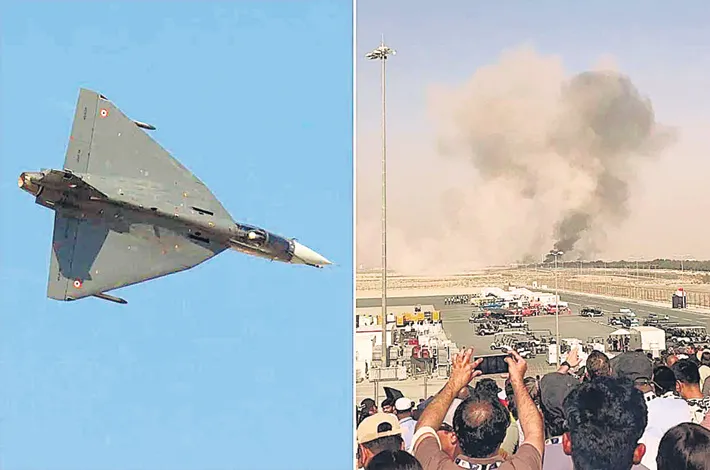LCA crashes in Dubai: Warning bells ringing?
23-11-2025 12:00:00 AM

In a shocking turn of events at the ongoing Dubai Air Show, an Indian Air Force (IAF) Light Combat Aircraft (LCA) Tejas Mk-1 crashed during a flying display at Al Maktoum International Airport on Thursday afternoon. The single-seat fighter, developed by Hindustan Aeronautics Limited (HAL), went down at approximately 2:10 p.m. local time in front of thousands of spectators. The IAF has confirmed that the pilot, an experienced display pilot, suffered fatal injuries. No ground casualties were reported.
The aircraft was performing a low-level aerobatic maneuver when it suddenly nosedived and impacted the ground, bursting into flames. Eyewitness videos circulating on social media show the jet failing to recover from what appeared to be a negative-G turn. Notably, no ejection was observed, despite the Tejas being equipped with the highly regarded Martin-Baker zero-zero ejection seat capable of saving the pilot even at ground level.
This is the second Tejas crash in less than two years. In March 2024, another Tejas went down in Rajasthan’s Jaisalmer during a training sortie, though the pilot ejected safely that time. The IAF has already constituted a Court of Inquiry to ascertain the exact cause of Thursday’s accident. Defense experts described the incident as a major setback for India’s indigenous fighter program, especially as the Tejas was being aggressively marketed for export at the Dubai Air Show. Several countries, including Argentina, Egypt, and the Philippines, had shown interest in the 4.5-generation multi-role aircraft.
A retired Wing Commander of the Indian Air Force cautioned against premature conclusions saying that it was too early to blame pilot error, mechanical failure or any specific system. Admitting that initial reports mention a possible failure to recover from a negative-G maneuver and even unconfirmed rumors of oil leakage, but still he called for patience till the inquiry was completed. He opined that such incidents, though tragic, were part of aviation, even with the best manufacturers worldwide.
Another senior retired army official called it a “definite setback” to the Tejas export campaign. He mentioned without mincing words that while, on one hand we were competing against top-tier global fighters, such incidents will raise questions in the minds of potential buyers. However, he stated that such accidents happen even to the most advanced platforms like the F-35. He also added that the Tejas uses the proven American GE F404 engine, and our pilots are among the best. “This appears to be an aberration, but the timing and location make it particularly damaging.” he said.
Experts highlighted that investigations will minutely examine several critical areas: flight control laws (the Tejas is a fly-by-wire aircraft), possible software glitches, engine performance, maintenance procedures abroad, environmental factors, and human factors. The involvement of artificial intelligence tools in modern crash investigations was also noted as likely to speed up and deepen the probe.
Another retired Brigadier however remained optimistic about the program’s future. He stated clearly that this was a Tejas MK-1 while the much more advanced Tejas MK-2 was already in the pipeline with operational clearance and firm orders. While accepting that one or two incidents in decades of operations do not define a platform, he called for shifting the focus to accelerating Mk-2 production and tightening quality control at HAL.
As India pushes its “Make in India” defense narrative on the global stage, Thursday’s tragedy serves as a grim reminder of the challenges in developing and marketing a homegrown fighter jet. While experts unanimously agree the program will recover, the road ahead for Tejas exports has undeniably become steeper.








